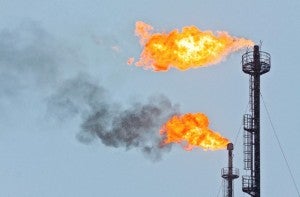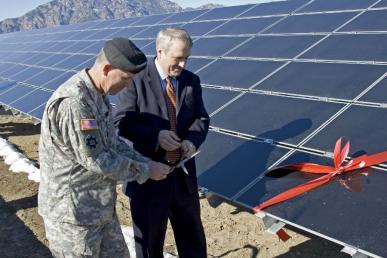 Nearly every month, for the past six months, a new scientific study has been released that provides new insights in to where methane, a highly potent, climate-destabilizing greenhouse gas, could be reduced across the entire natural gas system – the next six months will be no different. But this week, a new joint Purdue-Cornell study published in the Proceedings of the National Academy of Sciences revealed high emissions from drilling.
Nearly every month, for the past six months, a new scientific study has been released that provides new insights in to where methane, a highly potent, climate-destabilizing greenhouse gas, could be reduced across the entire natural gas system – the next six months will be no different. But this week, a new joint Purdue-Cornell study published in the Proceedings of the National Academy of Sciences revealed high emissions from drilling.
Monthly Archives: April 2014
High Methane Emissions in PA Reinforce Need for Strong Regulation
Why America Needs Methane Policy
Recently, the White House took a crucial stride to tackle methane pollution and natural gas waste. A key aspect of the strategy tasks the U.S. Environmental Protection Agency (EPA) with enacting policy to reduce emissions from the oil and gas industry. Yesterday, EPA formally initiated its process, issuing five white papers focused on the biggest opportunities to cut the industry’s methane emissions. A final decision for action is expected later this year.
The Administration’s strategy to reduce methane emissions is an urgently needed development to slow the rate of climate change in our lifetimes. That’s because methane is an incredibly powerful and climate-destabilizing greenhouse gas. Whether you’re a concerned citizen who wants better protections from pollution, an individual compelled to see the U.S. do more to defend the people and places most vulnerable to global climate change, or an energy watchdog who wants to minimize needless waste—know that solutions are within our grasp.
Let’s look at a key piece of the process that the White House galvanized and that EPA has now started to carry forward. EPA’s white papers provide thorough, technical assessment of oil and gas methane emission sources and mitigation technologies, and they provide the factual basis to support policy action. The process requests feedback from the public and a range of expert stakeholders that will help EPA answer: Is now the time to create a real methane policy for oil and gas? I am optimistic the answer will be a resounding “YES.”
Four Ways the U.S. Military Can Adopt Clean Energy for National Security
At the U.S. Defense Department, the multiple national security threats created by sea level rise and severe weather command daily attention; climate change has been on its radar for years. The recently published Quadrennial Defense Report (QDR), an assessment of U.S. defense readiness, addresses the growing threat that climate change poses to military capabilities and global operations. Adding to that, the newly released Intergovernmental Panel on Climate Change report states that extreme weather events will begin occurring more frequently across the globe. As first responders in the wake of extreme weather events, the U.S. military will be called upon to provide emergency support and services for a large portion of them.
The timing of these reports highlights a growing defense challenge but also provides an opportunity for the Defense Department to lead from the front in climate change mitigation and adaptation. Read More
EDF Helps Standardize Energy Efficiency Projects in Texas
By: Matt Golden, Senior Energy Finance Consultant
 Texas currently has the highest rate of energy consumption of any U.S. state and accounts for 10% of the country’s total energy consumption. Most of that energy goes to energy-intensive industries, such as aluminum, chemicals, forest products, glass, and petroleum refining, which consume 50% of the state’s energy, compared with a national average of 32%.
Texas currently has the highest rate of energy consumption of any U.S. state and accounts for 10% of the country’s total energy consumption. Most of that energy goes to energy-intensive industries, such as aluminum, chemicals, forest products, glass, and petroleum refining, which consume 50% of the state’s energy, compared with a national average of 32%.
Last year, the Texas legislature passed statewide legislation enabling cities to use their property assessment as a way to finance clean energy and energy efficiency for industrial, agriculture, water, and commercial buildings. This innovative financing tool, generally referred to as property-assessed clean energy (PACE), has the potential to unlock a considerable amount of funding for both renewable energy and energy efficiency projects in the state, while simultaneously offering building owners cheaper financing options and secure repayment through their property assessment. Read More
Changes to Electricity Systems Will Enhance U.S. Grid Reliability
 Last Thursday morning, with my heart quickly jumping, I entered the grandeur of the United States Senate hearing room for the Committee on Energy and Natural Resources’ Keeping the lights on — are we doing enough to ensure the reliability and security of the US electric grid? hearing as an invited witness. I was eager to share EDF’s vision of a cost-effective, clean energy system that enhances reliability − but I couldn’t help being a little awed by the moment. I had never testified on Capitol Hill before and the dignity of the setting and importance of the message I wanted to share weighed on me.
Last Thursday morning, with my heart quickly jumping, I entered the grandeur of the United States Senate hearing room for the Committee on Energy and Natural Resources’ Keeping the lights on — are we doing enough to ensure the reliability and security of the US electric grid? hearing as an invited witness. I was eager to share EDF’s vision of a cost-effective, clean energy system that enhances reliability − but I couldn’t help being a little awed by the moment. I had never testified on Capitol Hill before and the dignity of the setting and importance of the message I wanted to share weighed on me.
Here are the high points of my testimony (though you can read it in full here):
- The nation’s electricity system stands at a transformative crossroads: The costs of distributed generation technologies like rooftop solar and battery storage are falling and energy productivity is rising. In our digital world, people have increased demands for power quality and reliability, but needs for power quantity are predicted to fall – mostly due to “gains in appliance efficiency and an increase in vehicle efficiency standards by 2025.” As a result, our system is transforming from a one-way, centralized power delivery network in which customers passively receive electricity to a two-way flow of both power and information in which customers both receive and produce electricity. The very model of centralized, utility-scale power generation is no longer sacrosanct. The electricity systems we built in the last century, and the regulations that govern them, are no longer adequate – neither to ensure reliability, or to accommodate the rapid changes in technology, consumer needs, environmental standards, and the changing marketplace. Read More
Indiana Governor’s Inaction Results in First Rollback of Energy Efficiency Standards in the Nation
At the end of March, the Indiana legislature passed a bill repealing the state’s energy efficiency standard, becoming the first state in the nation to roll back its energy savings goals. Governor Mike Pence could have signed the bill into law or he could have vetoed it. He did neither; instead, the bill became law because he took no action within the prescribed time period. His statement as to why he allowed the bill to become law left us scratching our heads.
Here’s what he said:
“I could not sign this bill because it does away with a worthwhile energy efficiency program developed by the prior administration. I could not veto this bill because doing so would increase the cost of utilities for Hoosier ratepayers and make Indiana less competitive by denying relief to large electricity consumers, including our state’s manufacturing base.” Read More


